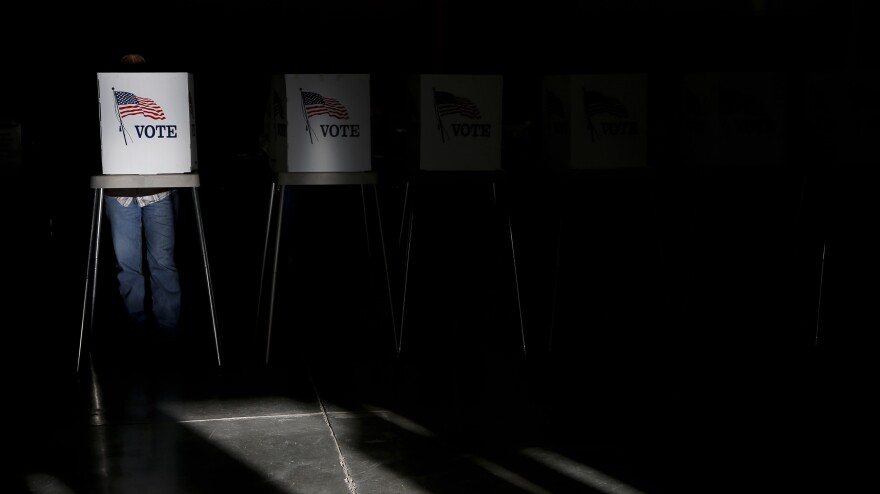Several states are trying to do something about so-called hyperpartisanship by changing the way congressional districts are drawn and the way elections are held.
Their goal: force members of Congress to pay more attention to general election voters than to their base voters on the right or left.
John Fortier, the director of the Democracy Project at the Bipartisan Policy Center, which is working on ways to make politics less dysfunctional, says U.S. political parties have become more polarized.
"One thing that that means is that Republicans are sitting in pretty safe Republican seats and Democrats are sitting in safe Democratic seats," Fortier says. "So, really it is across the board. There are not as many centrists, not as many competitive seats."
During the government shutdown fight we learned that conservative Republicans in the House answer to a different political calculus than do national Republicans. They represent safe conservative districts, which meant they were more concerned about a primary challenge from the Tea Party than a general election fight with a Democrat.
One reason is that congressional district boundaries are drawn by politicians to make their seats as safe as possible. It is a system where politicians get to choose their voters instead of the other way around.
Several states are trying to change that. The redistricting process occurs once every 10 years, after a new census is taken, and in North Carolina, there is a bill to have the lines drawn by the nonpartisan Legislative Services Office.
"It would take redistricting out of the hands of politicians and put it into the hands of professional staff who would be forbidden from drawing those districts for political purposes," says Steve Greene, a political scientist in North Carolina.
Population, not political affiliation, would be the only criteria. Greene says that would be a big change for North Carolina's congressional district map.
"Right now, North Carolina has nine Republican seats and four Democratic seats in a variety of really crazy shapes," he says. "To be honest, that has got to be one of the most effective gerrymanders in what is really essentially a 50/50 state."
A New Way To Primary
Several states already have a bipartisan or nonpartisan redistricting process. California, for instance, enacted another reform aimed at limiting hyperpartisanship called the top-two primary. It was passed by a voter referendum and spearheaded by Steve Peace, a former Democratic state legislator. He is also famous for producing the cult movie Attack of the Killer Tomatoes, which Peace says was really about politics.
"Killer Tomatoes was, I hate to have people take it too seriously, it is about killer tomatoes, but it also really was about government dysfunction and about the absurd way in which we react and overreact to crisis," Peace says.
With the top-two primary system, Peace set out to make California politics a little less absurd and a little less partisan. Under the system, just one open primary is held in each congressional district. All of the candidates are on the ballot: Republican, Democrat, third party. Any registered voter can participate, and the top two candidates go on to the general election.
In extremely conservative districts, it is often two Republicans. In very liberal districts it is two Democrats. The law went into effect just last year, so it is too early to draw conclusions, but Peace says it is already having an effect on elected officials.
"It's not about who gets elected; it's about how they behave after they get elected," he says. "The truth is, most politicians are far more reasonable human beings than we appear to be in public, because we all act like idiots trying to appeal to that narrow partisan base that we're dependent upon for re-election. You can see the evidence of that in this last shutdown vote."
Peace points out that half of California's Republican members in Congress broke with the Tea Party on the shutdown. In Washington state, where nonpartisan primaries have been in place since 2008, all of the Republican members of Congress voted against the shutdown.
Helping Politicians Help People
Dan Schnur, a former Republican strategist who now runs the Jesse Unruh Institute of Politics at the University of Southern California, says the combined effect of nonpartisan redistricting and the top-two primary is making the state's politics less polarized.
"What that's done is created a much more responsive group of legislators and congressional members because they know that their re-election is not solely dependent on the ideological base of their own party," Schnur says. "They can actually work across party lines without having to worry about the Tea Party or Move On running a primary challenge against them."
Democrats still have a strong majority in California's Legislature, but their voting records are becoming more moderate and pro business. Schnur says there are lessons for Republicans in these changes.
"At the national level you're just beginning to see the so-called Republican establishment starting to figure out a way to push back against the Tea Party," he says. "These types of reforms wouldn't eliminate conservative Republicans any more than they'd eliminate liberal Democrats, but what they would do is eliminate the disincentive for Republicans to find ways to work with people on the other side of the aisle."
The purpose of changes like the top-two primary and nonpartisan redistricting is to try to realign the political incentives for elected officials, so that serving the public and getting re-elected are not in conflict.
Copyright 2021 NPR. To see more, visit https://www.npr.org.




